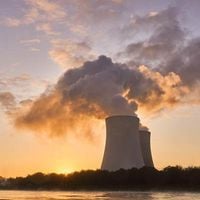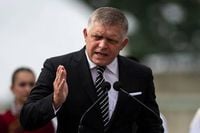Slovakia is poised to make a major leap in its energy future after Prime Minister Robert Fico announced a multi-billion-euro agreement with the United States to construct a new nuclear reactor. The deal, which was revealed on October 7, 2025, during an annual nuclear conference in Bratislava, marks a significant step in the country’s ongoing commitment to nuclear power and energy independence.
According to the Associated Press, Prime Minister Fico told attendees at the conference that his government had officially approved the agreement, which will see an additional nuclear reactor built at the existing Jaslovské Bohunice nuclear plant in western Slovakia. The new reactor is expected to have an output exceeding 1,000 megawatts and, crucially, will be fully owned by the Slovak state.
"The government has approved an agreement with the United States to build an additional nuclear reactor," Fico declared, as reported by multiple outlets. The announcement was met with a mix of anticipation and curiosity, as the prime minister did not provide further details regarding the exact timeline for signing the agreement or the projected completion date for the reactor.
This development follows a plan approved by Fico’s government in 2024 to construct a 1,200-megawatt nuclear unit at the same site. The Jaslovské Bohunice facility, operated by the dominant utility Slovenské Elektrárne, currently houses two nuclear reactors, both of which are critical to Slovakia’s power grid. The new reactor will be built alongside these, further cementing the plant’s status as the backbone of the nation’s electricity supply.
The project’s price tag is substantial. As highlighted by the Associated Press and other sources, the estimated cost could reach up to 15 billion euros, or approximately 17.5 billion US dollars. This level of investment underscores not only the scale of the engineering challenge but also the government’s belief in nuclear energy as a long-term solution to Slovakia’s energy needs.
Interestingly, the path to this agreement has not been straightforward. Initially, the Slovak government planned to select a builder for the new reactor through a public tender—a competitive process that would have allowed multiple international firms to bid for the contract. However, as negotiations progressed, the government opted instead to pursue a direct deal with the US-based company Westinghouse. This shift reflects both the urgency of Slovakia’s energy ambitions and the growing influence of American nuclear technology in the region.
Slovakia’s reliance on nuclear power is already among the highest in Europe. The country currently generates over 80% of its electricity from its two nuclear plants, a figure that places it at the forefront of nuclear-powered nations. The addition of a new reactor at Jaslovské Bohunice is expected to further solidify this position, reducing Slovakia’s dependence on fossil fuels and imported energy sources.
This move comes amid a broader trend of nuclear expansion in Central and Eastern Europe. The Associated Press notes that Slovakia’s neighbor, the Czech Republic, has recently signed a contract with Korea’s KHNP to build two more nuclear reactors. Meanwhile, Poland has struck a deal with Westinghouse to build its first nuclear power plant, and Hungary is moving ahead with plans for two new reactors to be built by Russian energy giant Rosatom. The regional momentum is unmistakable, with governments seeking to bolster energy security and meet ambitious climate targets.
For Slovakia, the decision to partner directly with Westinghouse carries strategic significance. Westinghouse, a major player in the global nuclear industry, has been expanding its footprint in Europe as countries seek alternatives to Russian technology and fuel. The collaboration is expected to bring advanced reactor designs and operational expertise, positioning Slovakia at the cutting edge of nuclear innovation.
Yet, as is often the case with large-scale infrastructure projects, questions remain. Prime Minister Fico did not specify when the agreement with the United States would be formally signed, nor did he outline a definitive construction timeline. Such details will be critical in the months ahead, as the government works to translate its ambitious vision into reality.
The decision to fully own the new reactor is also notable. In an era when many countries have opted for public-private partnerships, Slovakia’s insistence on state ownership reflects a desire for maximum control over its energy assets. This approach, while potentially limiting outside investment, ensures that strategic decisions remain in the hands of Slovak authorities—a point of pride for Fico’s populist administration.
Public reaction to the announcement has been mixed but generally supportive, given the country’s longstanding acceptance of nuclear energy. Environmental groups have raised concerns about the safety and long-term waste management associated with nuclear power, but such voices have been somewhat muted by the pressing need for reliable, low-carbon electricity. In a region often buffeted by energy price shocks and geopolitical uncertainties, the promise of greater self-sufficiency holds considerable appeal.
Slovakia’s nuclear ambitions are not occurring in a vacuum. The global energy landscape is undergoing rapid transformation, with countries grappling with the twin challenges of climate change and energy security. Nuclear energy, once maligned for its cost and complexity, is enjoying something of a renaissance as governments search for stable, low-emission power sources. The International Energy Agency has repeatedly emphasized the role of nuclear in achieving net-zero emissions by mid-century, and Slovakia’s latest move fits squarely within this narrative.
As the details of the agreement with the United States are finalized, all eyes will be on Bratislava to see how the project unfolds. The stakes are high, both in terms of financial investment and national prestige. If successful, the new reactor at Jaslovské Bohunice could serve as a model for other countries navigating the complexities of energy transition.
For now, Prime Minister Fico’s announcement signals a bold vote of confidence in nuclear power’s role in Slovakia’s future. With the world watching, the country stands on the cusp of a new era in its energy story—one defined by innovation, partnership, and a relentless pursuit of security and sustainability.

